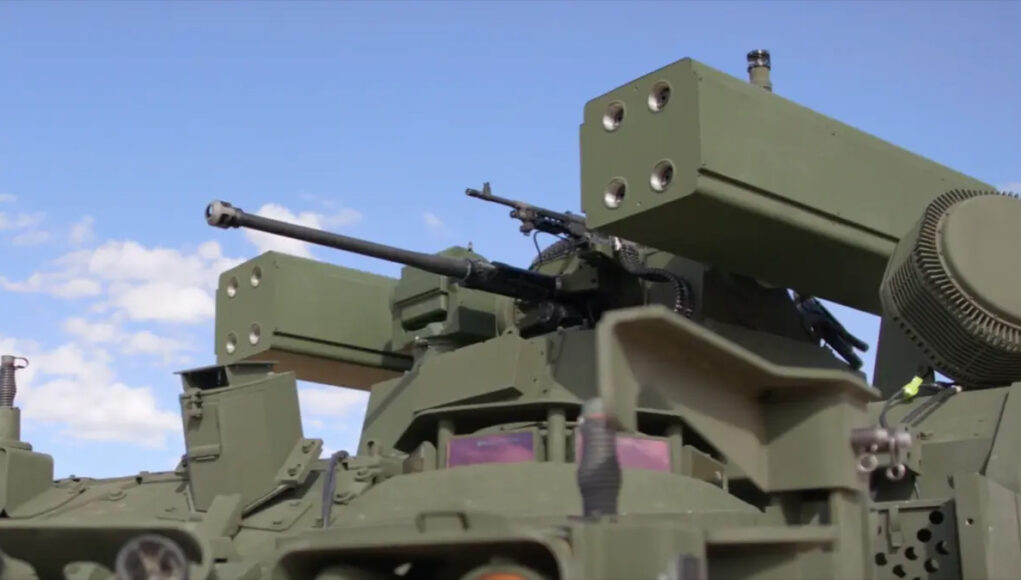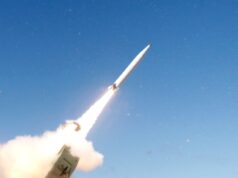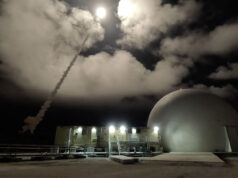During a recent live demonstration at the Big Sandy range in Kingman, Arizona, BAE Systems presented the capabilities of its Armored Multi-Purpose Vehicle (AMPV) Counter-Unmanned Aircraft System (C-UAS) prototype.
The event, part of a collaboration with Moog, was aimed at displaying the prototype’s proficiency in accurately engaging with both stationary and mobile aerial and ground targets.
The AMPV C-UAS prototype, according to BAE Systems, successfully demonstrated its ability to detect, track, identify, and incapacitate threats in a variety of simulated battlefield scenarios. The demonstration highlighted the system’s use of “slew-to-cue” technology to target small drones using 30mm proximity rounds.
The AMPV C-UAS prototype, which incorporates the same chassis used in the family of vehicles (FoV), also includes enhancements like BAE Systems’ External Mission Equipment Package (ExMEP) top plate. This feature is cited as enabling quick integration of future technologies and capabilities, as evidenced by its compatibility with more than 30 turret systems, including the U.S. Army’s validated Maneuver-Short Range Air Defense (M-SHORAD) turret.
Moog’s integration of the system includes various components such as Leonardo DRS’ Multi-Mission Hemispheric Radars (MHR), associated command and control systems, and Northrop Grumman’s XM914 30mm cannon, elements that are also utilised in the M-SHORAD system.
Following the award of a full-rate production contract in 2023 for five distinct variants of the AMPV, BAE Systems is actively fielding the FoV to Armored Brigade Combat Team (ABCT) units. The AMPV, as described by BAE Systems, represents a significant stride in enhancing the power, mobility, interoperability, and survivability of the Army and its allied forces.










Get some bought and into service! This is a big gaping dangerous hole in the army’s front line force. Or what’s left of it.
Not until they’ve bespoked it to oblivion.
Or ” …inform future decisions…”
Ahhhhh! That phrase that’s driven me mad for at least a decade.
You’ve been reading my posts…😉
That’s the one….the decisions that are never made before the next wave of trials as the cans kicked further down the road.
IAV 2024: British Army mulls procurement of interim SHORAD system31 January 2024
“The British Army is considering the procurement of a new mobile short-range air defence (SHORAD) system to replace its Stormer-based self-propelled high-velocity missile (SP-HVM) system, Janes learnt at Defence iQ’s International Armoured Vehicles (IAV) 2024 conference held in London from 22 to 25 January.
While Janes understands that a business case for the procurement has not yet been approved and that its primary justification would be to fill the gap left by the donation of Stormer systems to Ukraine, the material presented at the IAV conference implies that the new system could take over the mobile SHORAD role once the Stormer reaches its planned out-of-service date in 2026.”
Another possible option.
MSPO 2023: Hanwha Defense unveils Biho II mobile air defense system
“During the MSPO 2023 defense exhibition in Poland, the South Korean company Hanwha Defense is unveiling a new version of its Biho II mobile air defense system.
This advanced system is built on the 8×8 wheeled chassis of the Tigon armored vehicle, marking a significant departure from previous Biho models that used a single 30 or 40mm automatic cannon capable of firing airburst ammunition.
Unlike its predecessor, this new model is based on the 8×8 wheeled chassis of the Tigon, which was initially revealed at the DX Korea defense exhibition in September 2018.
The hull of the vehicle is made of fully welded steel armor but can be reinforced with appliqué armor to improve its resistance against ballistic and mine threats.Under the hood, the Biho II is equipped with a power pack developed by Caterpillar. It includes a turbocharged and intercooled 6-cylinder inline diesel engine that generates 525 horsepower.
The engine is coupled to a 4500SP electronically controlled automatic transmission from Allison, featuring six forward and one reverse gear.
The Biho II is fitted with an unmanned turret that can be armed with a 30 or 40mm gun capable of firing airburst ammunition. This new type of tactical anti-personnel explosive ammunition detonates in mid-air, causing airburst effect fragment damage to enemy targets.
Operated by a crew of three people—a driver, a commander, and a gunner—the Biho II is designed for efficiency and rapid responsiveness. In addition to its main armament, the vehicle can also be equipped with surface-to-air missile launchers that can be mounted on the side of the turret’s roof.
The turret is also equipped with a small target radar mounted on its right side, with a maximum range of 15 km. Additionally, a surveillance radar is mounted on the roof of the turret, extending its maximum range to 35 km. The system can track fighter aircraft up to a range of 7 km and Unmanned Aerial Systems (UAVs) up to 3 km.”
defense_news_september_2023_global_security_army_industry/mspo_2023_hanwha_defense_unveils_biho_ii_mobile_air_defense_system.html
There are increasing numbers of systems of this nature after years of anti air gun systems becoming ‘obsolete’ which just shows sometimes you have to go back to the future and older concepts not simply disregarded as the Gerard has proved. Important that the UK adopts this new generation for anti drone combo systems. Need to check out the competition and buy whatever is most suitable and effective be it existing or mounted on another uk specific platform. Clearly support and logistics play a role.
Gerard hehe some old bloke pointing his walking sticks into the sky going ratatata… I love autocorrect
A pretty essential and OTS solution to drone and other aerial threats. I’m sure it shouldn’t take longer than 15 years to get into service…..
Cynical, but quite likely to turn out to be true
For defence purposes against drones ,gun systems are a better and cheaper way of destroying them,hms diamond chucked very expensive missiles like us navy at drones ,but then you can have drones that that are small like the ones blowing up Mr putins army 😀 dropping small one kg bomb in the turret, the way warfare is changing its frightening,
the US army has just brought into service a stryker variant with a 60kw laser turret on top along with 360 degree AESA coverage. surprised that isn’t getting more news! seems like the perfect solution for the drone problem.
Don’t suppose we’ll ever see any of these.